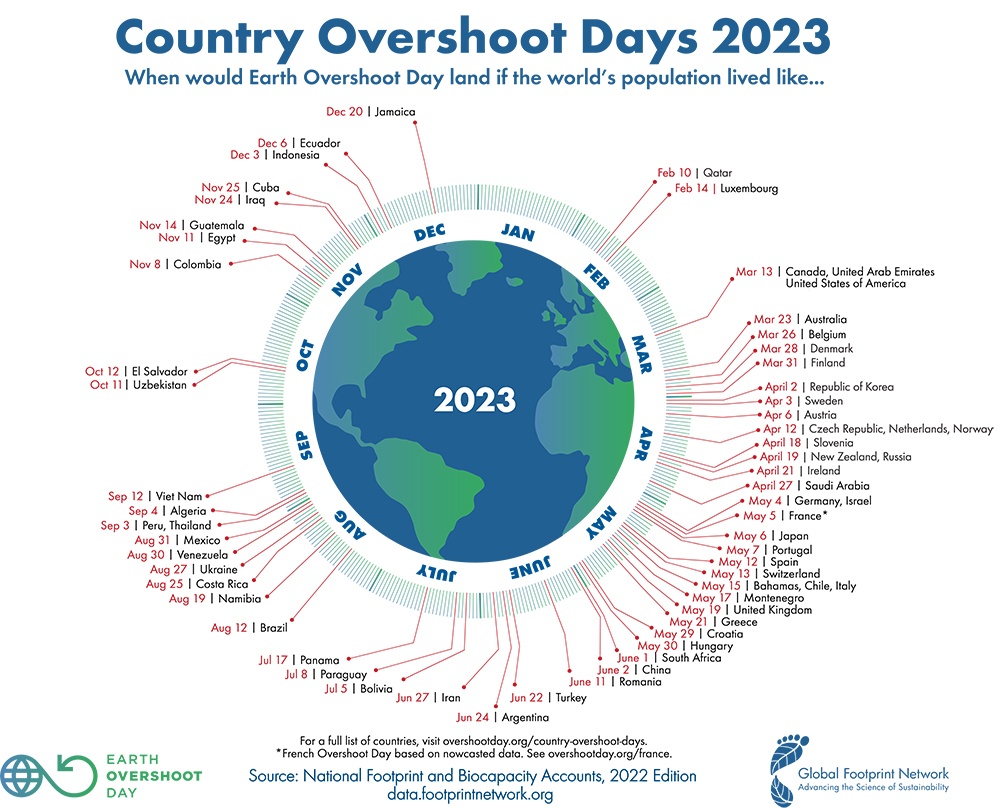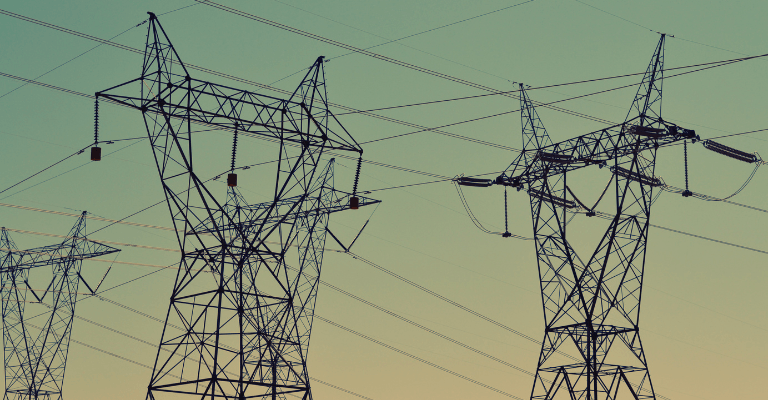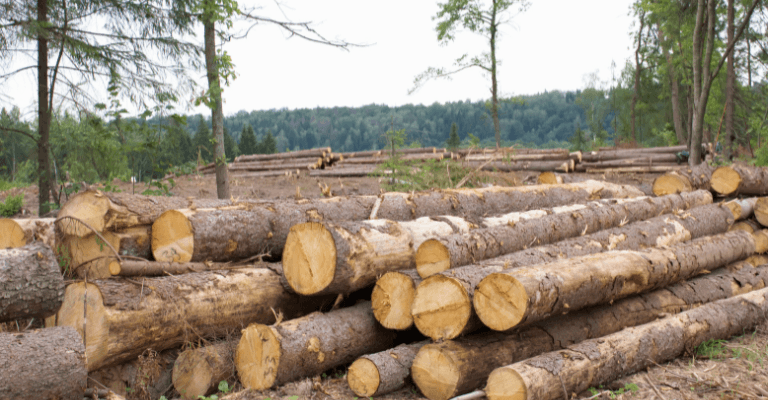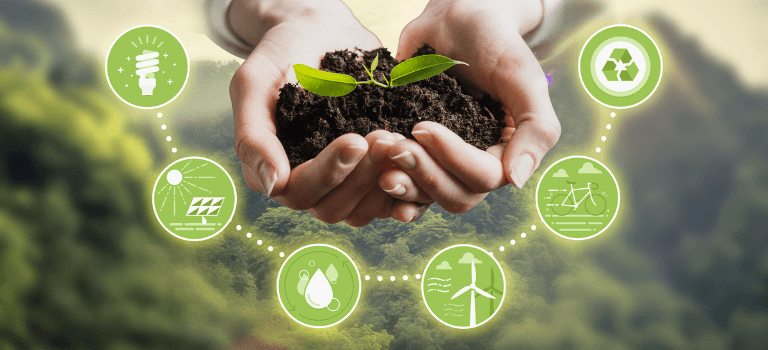As the world grapples with the ever-increasing strain on our planet’s natural resources, one date stands out as a stark reminder of our unsustainable trajectory: Earth Overshoot Day. In 2023, this pivotal day falls on August 2nd. This annual date serves as a wake-up call, reminding us of the pressing need to address the ecological imbalance between our unsustainable consumption habits and Earth’s regenerative capacity.
Understanding Earth Overshoot Day
Hosted and calculated by the Global Footprint Network, Earth Overshoot Day marks the date when the human population’s demand for our planet’s resources and services in a given year exceeds what the Earth can regenerate in that year. Simply put, Earth Overshoot Day marks the date when we have ‘used up’ all the resources the Earth has provided for us for that one year.
To determine the date of Earth Overshoot Day, the Global Footprint Network divides the Earth’s biocapacity (the amount of natural resources the planet can produce/regenerate in a year) by our ecological footprint (the amount of resources the population consumes), and then multiplies this by 365 (the number of days in a year).
(Earth’s Biocapacity / Humanity’s Ecological Footprint) x 365 = Earth Overshoot Day

The resulting date is the predicted date that humanity will have used up the Earth’s available resources for that year, and the remainder of the year corresponds to global overshoot where we are essentially ‘borrowing’ from next year’s allocation of resources. Based on that equation, the larger our ecological footprint is, the earlier the date will fall.
2022 and 2023 Earth Overshoot Day
Earth Overshoot Day can be calculated for each country, and the dates for every country will be combined to give a global Earth Overshoot Day. Not all countries will have an overshoot day, however, if its ecological footprint is smaller than its biocapacity. In 2022, global Earth Overshoot Day fell on July 28 – tied first for the earliest overshoot day we’ve had since 2018, in which overshoot day also fell on July 28th. This means it would take around a year and a half to replenish what we used up in 2022.
In 2023, Earth Overshoot Day falls on August 2nd. While it may seem like an improvement from 2022, the five-day delay isn’t as positive as you might think since improved datasets were utilized for this year’s calculation, providing a more accurate date than previous years.

Canada’s Demand on Natural Resources
If the world’s population all lived like Canadians, global Earth Overshoot Day in 2023 would fall on March 13th, which is when Canada’s 2023 overshoot day has been calculated to be. With such a small population on such a large piece of land, how can Canada’s overshoot day fall so early? Several factors contribute to Canada’s comparatively early date, including but not limited to:
High Per Capita Consumption
Canada has one of the highest per capita consumption rates globally, especially in energy. Energy consumption in Canada is nearly 3 times the global average.

Heavy Reliance on Resource-Intensive Industries
Canada’s economy relies heavily on our natural resources, such as mining, logging, and energy extraction (e.g., fossil fuels). These sectors have large ecological footprints and can result in resource depletion.

Carbon Intensity
Due to our reliance on fossil fuels, Canada faces challenges in reducing carbon emissions, thereby contributing to ecological overshoot.

Land Use Changes and Biodiversity Loss
The expansion of urbanization, agriculture, and industrial activities onto natural landscapes has led to habitat loss and fragmentation, resulting in negative effects on biodiversity and the ecological balance of the environment.

What can we do?
While this may all seem overwhelming (as individuals) to fix, every little action we make helps us take a step in the right direction. Here are several small actions we can take:
- Embrace sustainable consumption: Become more conscious of your spending habits and practice responsible consumption. Opt for products with minimal packaging, prioritize quality and durability, and consider buying second-hand items instead of new ones. Supporting local businesses and farms not only strengthens your community but also reduces emissions linked to long-distance transportation.
- Reduce your energy consumption: Start by opting for energy-efficient appliances that are kinder to the environment and your wallet. Take it up a notch by installing smart devices like smart thermostats that intelligently cut down energy consumption when your home is unoccupied. And don’t forget the simple yet effective trick of unplugging appliances that aren’t in use.
- Minimize your food waste: Reduce your food waste by thoughtfully planning meals while only buying what you need. Don’t forget to store leftovers properly to keep them fresh and enjoyable for longer. And for those food scraps that can’t be eaten consider composting to avoid organic waste from ending up in the landfill if your municipality does not have a compost program in place.
- Conserve water: Implement water-saving habits, such as turning off the taps while brushing your teeth, collect rainwater for gardening, and choose water-efficient appliances. It’s equally important to avoid water-contaminating practices, such as washing your car on the driveway. When the water runs down the sidewalk, it bypasses water treatment facilities, ultimately ending up in natural water bodies, causing harm to the environment.
- Advocate for change within your community: Share your knowledge and experiences with friends, family, and your community. Highlight the positive impacts you have observed through your individual actions. By leading through example, you become an inspiration, encouraging others to embrace sustainable habits too.

In Conclusion
Addressing Earth Overshoot Day requires collective action from everyone to prioritize sustainable practices and resource conservation. By embracing these solutions and inspiring others to join the sustainability movement, we can help extend Earth Overshoot Day and work towards a more sustainable and resilient future. Remember, it’s not about perfection but the collective effort of imperfect sustainability that will make a significant and lasting impact. Together, we can forge a path towards a more sustainable and resilient future for generations to come.

We encourage you to learn more!



